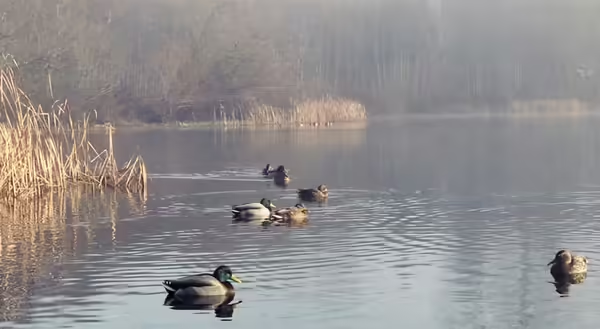
Dawn is breaking over a quiet pond. An early December wind sweeps through rustling Big Bluestem, Bottlebrush Grass, and seedhead ghosts of late-season blooms. A muskrat slowly retreats to a half-built lodge as the morning grows brighter. It is unseasonably cold. All is quiet, until a feint flapping of wings is heard above. It grows louder—and louder. Then, with a cacophony of quacks, six mallard ducks splashdown in a dramatic entrance.
Observations in nature that note the behaviors of a certain species at a specific time of year and in relation to the current climate is the science of phenology. Phenological observations are “like nature’s calendar – when cherry trees bloom, when a robin builds its nest, or when leaves turn color in fall”, according to the USA National Phenology Network.
With climate change upon us, phenological observations will tell the careful naturalist how any living thing reacts to climate changes over time. Those observations constitute valuable, real-time data. When reported at regular intervals, the data helps scientists draw conclusions that shape future approaches to conservation efforts.
When tracking some species, like the eastern monarch butterfly (Danaus plexippus), their pattern of behaviors can keep even the keenest observers on their toes. The eastern monarch butterfly can migrate as far as 2,500 miles to reach their overwintering site in the mountain forests of Mexico. In days past, their fall arrival and spring departure times to this area were predictable. Now, however, the monarchs' reactions to factors unknown could be altering this timeline.
In a June 2022 article from Lincoln Courier, Illinois Farm Bureau and Illinois Press Association reported that the monarchs “left (their wintering grounds) in February of 2021...(in 2022)...they stayed until April.”
Mexican conservation staff are now witnessing how the late departure in spring resulted in a late arrival of monarchs in the fall. Monarchs returned to their forest roosting sites of Mexico on Saturday, November 5, according to Mexican environment officials. A late arrival with cultural significance. Typically, arriving on November 1, Mexican folklore regards monarchs as departed souls returning to living family members on Día de los Muertos (Day of the Dead).
With some simple observation skills and a calendar, conservation officials discovered a disruption in the migration pattern of monarchs. With knowledge of the disruption, scientists can take additional action to help the monarchs.
Not all science is challenging, or off-limits to nonscientists; some science, like phenology, is grounded in the simple and repeat observations of nature. A practice that connects us with the rhythms of nature and alerts us to asynchrony. Start your observations today and discover the beautiful patterns of the natural world.
Photo Credit: Ducks in a foggy pond by CClogg CC0 1.0
ABOUT THE AUTHOR: Nick Frillman is a Local Foods and Small Farms Educator serving Livingston, McLean, and Woodford Counties. A fourth-generation graduate from University of Illinois, Frillman has a B.A. with a double major of Political Science and Spanish and a M.S. in Crop Science with a focus on crop production. Before joining Illinois Extension, Frillman completed a field season of CSA and farmers’ market-style production at a small “beyond-organic” vegetable farm in Sandy, Oregon.
ABOUT THE EDITOR: Liz Repplinger is the Agriculture and Natural Resources Program Coordinator serving Livingston, McLean, and Woodford Counties. A Bloomington-Normal native, Liz earned a B. A. in Animal Science and an M.S. in Animal Science from Illinois State University. She has enjoyed contributing to the multiple facets of Extension including previous support of the 4-H Youth Development Program as a program coordinator and current support of Unit and Statewide Diversity, Equity and Inclusion Initiatives.